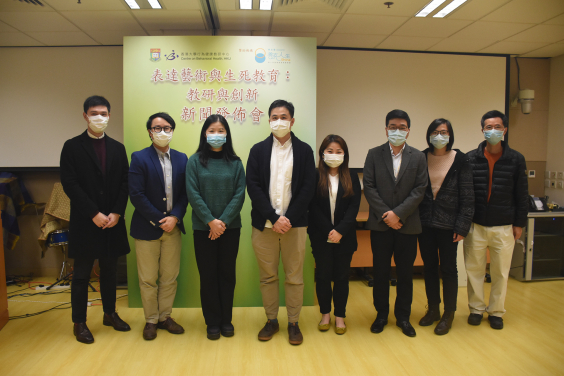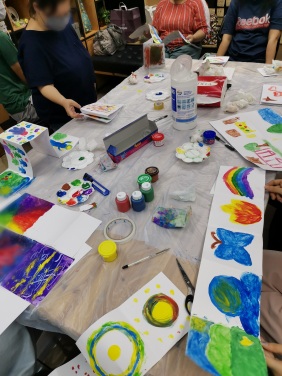Media
The Application of Expressive Arts in Life-and-Death Education in Hong Kong: Research and Innovation
Research Findings and Discussion
30 Dec 2021
The COVID-19 pandemic has ravaged the world in the last couple of years. Issues of life and death have never been so close. In fact, life and death issues should always be part of our value education, but due to factors such as the lack of resources and cultural constraints, life and death education is still in its early stages in Hong Kong despite its success in foreign countries. In the Chinese culture, death is often being regarded as a taboo and people may find it difficult to discuss life and death topics in an open and direct manner. In this regard, an intervention method that fits the local culture which can gently facilitate the discussion of life and death issues is needed. Expressive arts could be a way to fill the gap.
In order to strengthen in professionals and the public the awareness on life-and-death education and expressive arts, The Board of Management of the Chinese Permanent Cemeteries (BMCPC) funded an expressive-arts-based life and death education project – “The Application of Expressive Arts in Life-and-Death Education in Hong Kong: Research and Innovation”, which was conducted by the Centre on Behavioral Health of the University of Hong Kong between October 2019 and December 2021.
BMCPC was established in 1913 and is one of the most well-established private cemetery operators in Hong Kong. It is a statutory body which operates, manages and develops four cemeteries at Aberdeen, Tsuen Wan, Chai Wan and Junk Bay on non-profit making basis. Since 1991, BMCPC has funded over 3,300 charitable projects, with total donations of more than HK$1,000 million covering millions of beneficiaries.
At the press conference today (December 30), the Centre on Behavioral Health research team shared the experience in running the project and released findings of a questionnaire survey on its effectiveness.
“The Application of Expressive Arts in Life-and-Death Education in Hong Kong: Research and Innovation” consists of 4 components: 1. Public engagement seminars and workshops to bolster community awareness on end-of-life issues; 2. Train-the-Trainer (TTT) programme for frontline workers and health/allied health professionals; 3. Public educational videos on arts and life-and-death education; 4. Research study to explore the effectiveness and feasibility of adopting expressive arts in life-and-death education. The project has benefited over 3,500 people directly, and more than 3,000 people indirectly, including professionals and the general public. The documentary has recorded more than 40,000 views.
Throughout the project period, a total of more than 3,200 people participated in the five public education seminars. The five seminars revolved around five major themes: helping children understand life and death, accompanying ageing parents, experiencing grief through art, living in the present through art, and taking graduation photos in life. Through sharing from experts, participants learned about expressive arts and life-and-death education, and discussed how to combine and popularize expressive arts and life-and-death education. On the other hand, the life-and-death experiential workshop led the public to reflect on life and death issues through artistic creation, raised society's awareness and allowed participants to experience the use of art as a medium for life-and-death education.
The project also launched a TTT programme for frontline workers and health/allied health professionals. The training programme was tailored by a team of expressive arts therapists and life-and-death education experts at the Centre on Behavioral Health. A total of 200 frontline workers received four days of training and supervision on basic concepts, skills, experience, mentality of using expressive arts, and on how to integrate expressive art into life and death education. They then proceeded to provide a 6-week group service programme in the community, serving over 3,000 audiences. Meanwhile, the five-episode documentary introduces the background, current situation, application, and trend of expressive arts and life-and-death education. More than 40,000 views have been recorded so far.
A survey was conducted to evaluate the effectiveness of the project with over 1,600 questionnaires completed by participants. The data collected helps researchers to understand the effectiveness of applying expressive arts to life-and-death education.
The research is conducted through randomized-controlled trial. Participants of the community programme were randomly assigned to two groups, the "experimental group" and the "control group". The questionnaires mainly revolved around the changes of the participants before and after the 6-week community programme, and follow-up questionnaires (at an interval of 6 weeks) were used to understand their anxiety on death, and their own death-related preparation arrangements.
The results showed that individuals who participated in the expressive-arts-based life-and-death education group have a significant reduction in death-related anxiety compared to the control group. They also demonstrated significantly higher motivations in signing a will, volunteering for organ donation, and arranging a resting place for themselves. The research team concluded that expressive-arts-based life-and-death education programme can effectively reduce the public’s anxiety on death and enhance their incentive to get prepared for their own death. Moreover, members of the public also reported that using art as a medium for life-and-death education is a lively, interesting and enjoyable exploration process. They have since become more willing to discuss issues of life and death.
For media enquiries and more details, please contact Ms. Amy Choi, Centre on Behavioral Health, HKU, Tel: 2831 5163; amychoi@hku.hk; Dr. Adrian Wan, Centre on Behavioral Health, HKU, Tel: 2831 5578; awan@hku.hk; or Ms. Melanie Wan, Communications and Public Affairs Office, HKU; Tel: 2859 2600, melwkwan@hku.hk.


